Research
Research Motto
Research Projects
1. Project to establish mechanism-based in vivo-in vitro
toxicity/carcinogenicity assay models.
Engineered nanomaterials, defined as 100 nm in diameter or less, are being introduced into the market worldwide because of their innovative physicochemical characteristics. Although some nanomaterials have been shown to induce tumors at the exposure site, their safety assessment is remains far behind their production. Our laboratory is working on a project to establish mechanism-based in vivo-in vitro toxicity/carcinogenicity assay models. Since nanomaterials are recognized as "foreign bodies" and phagocytosed by macrophages, we are focusing on the analysis of macrophage-related cytokines as possibly being responsible for their carcinogenic effect. (Carcinogenesis. 31:927-935, 2010; Food Chem Toxicol.;49:1298-1302, 2011)
- Transmission electron microscopic view of nano-size titanium dioxide
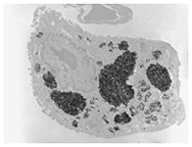
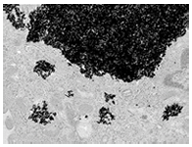
Transmission electron microscope appearance of nano-size titanium dioxide
(many of the particles are forming aggregates)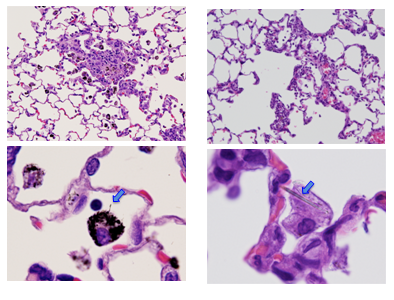
Multiplewall carbon nanotubes (left) and asbestos (crocidolite) (right).
They are being phagocytosed by alveolar macrophages;
some penetrate through the cell membrane (arrows).- Fullerene
-
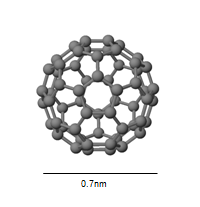
Fullerene(C60)
(Courtesy of Dr. M. Ata, National Institute of Advenced
Industrial Science and Technology) - Multiplewall carbon nanotube(MWCNT)
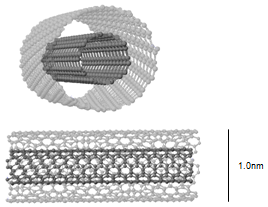
Multiplewall carbon nanotube(MWCNT)
(Courtesy of Dr. M. Ata, National Institute of Advenced
Industrial Science and Technology)
2. Lactoferrin
Lactoferrin is an iron binding protein originally discovered in milk and is an important component of the innate immune system with anti-microbial activity. Based on our observation that oral administration of bovine lactoferrin suppressed colon carcinogenesis in rats, we conducted a double blind clinical study and found that bovine lactoferrin reduces the size of small colon polyps. We are conducting a project to clarify the mechanism of this effect. (Biochimie, 91:86-101, 2009; Biometals23: 399-409, 2010; Cancer Prevention Research, 2: 975-983, 2009
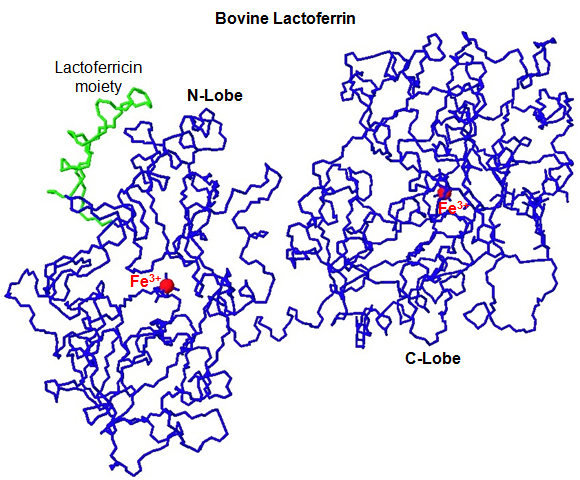
3. Rat model of pancreatic ductal carcinoma
Pancreatic ductal carcinoma (PDC) is one of the most debilitating cancers known. We have developed an animal model of PDC using mutated H/K-ras transgenic rats. PDC is induced in these animals by activating the H/K-ras transgene with adenovirus expressing Cre recombinase. Pancreas tumors closely resembling human PDC can be induced within a 4 week period. Induction of PDC can be easily diagnosed by serum ERC/Mesothellin levels. Assays of chemotherapeutic agents and tumor imaging studies utilizing this model are underway. (Carcinogenesis. 27: 2497-2510, 2006; Biochem Biophys Res Commun. 390: 636-641, 2009; Cancer Sci. 101: 341-346, 2010)
Expression of HA-KrasV12 in pancreatic lesion
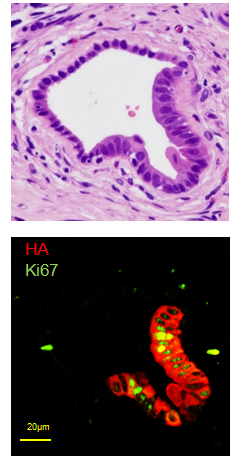
PanIN1 lesion
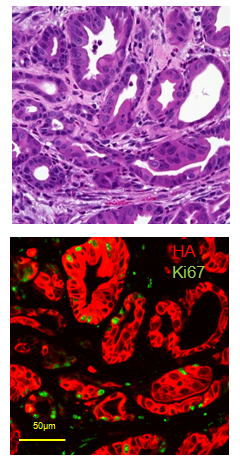
Pancreatic ductal carcinoma
Pancreatic ductal adenocarcinoma (PDA) induced by injection of Ad-CAG-Cre in Kras transgenic rats.The expression of hemagglutinin (HA)-KrasG12V (red) in PanIN1 lesion (Left) and pancreas ductal carcinoma (right). Cell proliferation (green) is preferentially seen in PanIN1 and ductal carcinoma lesions.
From "Tanaka, H.,et al. Mature acinar cells are refractory to carcinoma development by targeted activation of Ras oncogene in adult rats. Cancer Sci. 101; 341-346, 2010 ". This figure is reproduced with the permission of the publisher John Wiley & Sons Ltd.
4. Development of short/middle-term in vivo assay models of
carcinogens
Identification of environmental carcinogens is of prime importance in reducing cancer risk in humans. Conventional long-term chronic testing using rodents are too time consuming and costly. Dr. Tsuda has been engaged in developing an 8-week assay model using glutathione S-transferase positive preneoplastic hepatocyte foci in rats as an end point marker lesion, and, more recently, a 10-week assay model using mammary cancer prone human c-Ha-ras proto-oncogene transgenic rats. Based on our experience with these models, we are developing a short-term assay model for the evaluation of the carcinogenicity of nanomaterials. (Toxicol Pathol. 38:182-187, 2010; Carcinogenesis, 21:243-249, 2000; Tox. Pathol.35: 436-443, 2007 ) (Assays by models were available in DIMS and Tsuda's laboratories).



